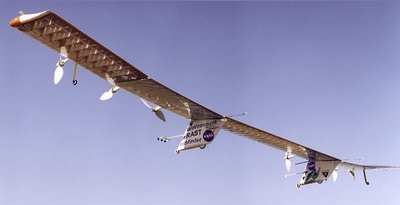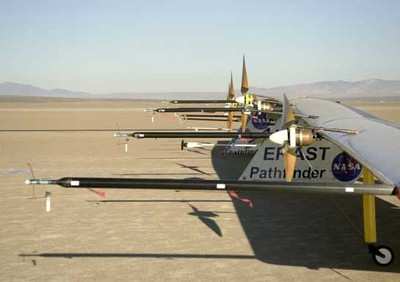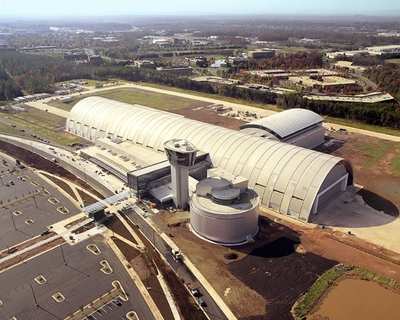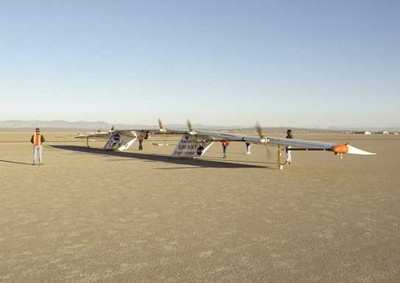Record-Setting Flying Wing On Display At Udvar-Hazy
Aero-News learned Monday the pioneering Pathfinder-Plus
solar-electric flying wing, that set several altitude records for
propeller-driven aircraft under NASA sponsorship, has been acquired
for the permanent collection of the Smithsonian Institution.

The ultra-lightweight flying wing was enshrined in the National
Air and Space Museum's Steven F. Udvar-Hazy Center at Dulles
Airport in suburban Virginia in late January, and is now
prominently displayed for public viewing among the center's fleet
of famed aerospace craft.
The original Pathfinder all-electric aircraft made its first
flight on battery power in 1983, and was later upgraded with solar
cell arrays to enable it to fly on the power of the sun. Its
successor configuration, Pathfinder-Plus, went on to establish
several flying records, including soaring to a world altitude
record for propeller-powered aircraft of more than 80,000 feet in
1998.
"The Pathfinder/Pathfinder-Plus peeled back some of the veils of
flight and explored new regimes," said John Del Frate of NASA's
Dryden Flight Research Center, Edwards AFB, CA, who managed most of
the NASA-supported flight research projects.

"The Pathfinder lived up to its name by gently plying its way to
record-setting altitudes, and those records speak for themselves,"
Del Frate added. "The aircraft didn't do it all by itself. It only
represented the efforts of a small, dedicated team that was given
the opportunity and the resources to make it happen."
Pathfinder Plus' record-setting flights led the way for its
successor, Helios, and for AeroVironment's next generation of
stratospheric unmanned aircraft systems, the Global Observer,
currently in development.
"The learning and technology developed from Pathfinder and
Pathfinder-Plus' successful missions have been invaluable toward
the continuing development of Global Observer, which we believe
represents the future of stratospheric flight," said Tim Conver,
president and chief executive officer of AeroVironment. "Innovation
drives our business, and the installation of Pathfinder-Plus in the
National Air and Space Museum, alongside some of the most storied
aircraft in aviation history, will enable the public to share in
this innovative aircraft's history."

Pathfinder was first developed for a classified government
program in the early 1980's to develop a high-altitude,
long-endurance aircraft for surveillance purposes. Known as HALSOL
(for High-ALtitude SOLar) aircraft, it was first powered by
batteries. After that project was cancelled, the aircraft was
stored for 10 years before being resurrected for a brief program
under the auspices of the Ballistic Missile Defense Organization in
1993. With the addition of small solar arrays, five low-altitude
checkout flights were flown under the BMDO program at NASA Dryden
in the fall of 1993 and early 1994 on a combination of solar and
battery power.
Pathfinder was adopted by NASA's Environmental Research Aircraft
and Sensor Technology (ERAST) program in 1994 to assist in the
development of unmanned aerial research platforms for the
stratosphere. With the addition of solar cell arrays across most of
its upper wing surface, Pathfinder flew to 50,567 feet near Edwards
AFB in 1995 on solar power, its first trip to the stratosphere. It
then flew to 71,500 feet in 1997 while performing a series of
high-altitude science missions over the Hawaiian Islands.
In 1998, Pathfinder was upgraded to become Pathfinder-Plus, with
a new center wing panel that increased the wingspan from 99 feet to
121 feet. Pathfinder-Plus was fitted with new high-efficiency solar
cells on its center wing panel and other improvements that enabled
it to set anther altitude record of 80,201 feet for
propeller-driven aircraft in August 1998.
The upgraded solar and control system technology validated in
the Pathfinder-Plus led to development of the Helios, which set the
current world altitude record for propeller-driven aircraft in
level flight of 96,863 feet near the Hawaiian island of Kaua'i in
2001.

During the summer of 2002, the Pathfinder-Plus flew several
demonstration missions over Hawaii to confirm the practical utility
of high-flying, remotely piloted, environmentally friendly solar
aircraft for commercial purposes, emphasizing its capabilities as a
relay platform for telecommunications and aerial surveillance of
crops. Pathfinder-Plus' final mission in September 2005 saw the
featherweight craft perform atmospheric turbulence measurements at
Edwards AFB under the auspices of NASA Dryden.
The National Air and Space Museum's Steven F. Udvar-Hazy Center
displays among its artifacts the larger icons in the museum's
collection, including a Lockheed SR-71 Blackbird, the space shuttle
prototype Enterprise, a Concorde and the "Dash 80" Boeing 707
prototype, along with thousands of other smaller items.
 ANN's Daily Aero-Linx (05.06.25)
ANN's Daily Aero-Linx (05.06.25) ANN's Daily Aero-Term (05.06.25): Ultrahigh Frequency (UHF)
ANN's Daily Aero-Term (05.06.25): Ultrahigh Frequency (UHF) ANN FAQ: Q&A 101
ANN FAQ: Q&A 101 Classic Aero-TV: Virtual Reality Painting--PPG Leverages Technology for Training
Classic Aero-TV: Virtual Reality Painting--PPG Leverages Technology for Training Airborne 05.02.25: Joby Crewed Milestone, Diamond Club, Canadian Pilot Insurance
Airborne 05.02.25: Joby Crewed Milestone, Diamond Club, Canadian Pilot Insurance






